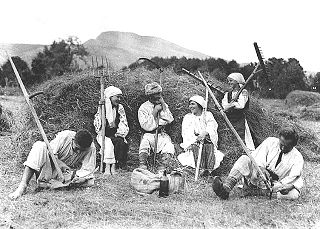Peasants' Party (Romania)
Peasants' Party Partidul Țărănesc | |
|---|---|
| Abbreviation | PȚ |
| Founded | 1918 |
| Dissolved | 10 October 1926 |
| Merged into | National Peasants' Party |
| Ideology | Agrarianism Poporanism Agrarian socialism |
| Political position | Left-wing |
| Colors | Green |
The Peasants' Party (
Background

In the years between Romania's proclamation as a
The problems posed by the rigid political structure were doubled by social issues culminating in the
Creation and activities
Although preceded by attempts to create a peasant party that would challenge the existing situation (began in the 1880s with a group around
The Peasants' Party was founded in
; for a while during 1919, the united party existed under the name Peasants' and Laborer Party (Partidul Țărănesc și Muncitor), before again adopting the 1918 version.Especially considering its recent emergence, the Party registered a major success in the 1919
Alliance policy and creation of the PNȚ
These changes probably benefitted
To combat the Liberal hegemony, the PȚ had already started negotiations with other opposition groups, including the
New talks ushered in by Averescu's nomination in 1926 led to a compromise between Maniu and Mihalache. On October 10 of that year, the two parties joined into the
Legacy
The Peasant Party's legacy was soon claimed by splinter groups of the PNȚ, all of which situated themselves more to the
A more left-wing tendency linked with the Peasants' Party tradition remained present and distinct within the PNȚ. It was represented by, among others, Ernest Ene, Mihail Ghelmegeanu, Petre Andrei, and Armand Călinescu.
Notable members
- Zamfir Arbore
- Octav Băncilă
- Ioan Borcea
- Paul Bujor
- Armand Călinescu
- Nicolae Costăchescu
- Ernest Ene
- Mihail Ghelmegeanu
- Dimitrie Gusti
- Pan Halippa
- Iorgu Iordan
- Grigore Iunian
- Nicolae L. Lupu
- Virgil Madgearu
- Ion Mihalache
- Constantin Ion Parhon
- Victor Ion Popa
- Pamfil Șeicaru
- Constantin Stere
- Adolphe Stern
Electoral history
Legislative elections
| Election | Votes | % | Assembly | Senate | Position |
|---|---|---|---|---|---|
| 1919 | 61 / 568
|
28 / 216
|
4th | ||
| 1920 | 25 / 366
|
10 / 166
|
4th | ||
| 1922 | 40 / 372
|
11 / 148
|
2nd | ||
| 1926 | 16,824 | 0.7 | 0 / 387
|
0 / 115
|
8th |
Notes
References
- Vasile Niculae, Ion Ilincioiu, Stelian Neagoe, Doctrina țărănistă în România. Antologie de texte ("Peasant doctrine in Romania. Collected Texts"), Editura Noua Alternativă, Social Theory Institute of the Romanian Academy, Bucharest, 1994
- (in Romanian) Dumitru Șandru, Satul românesc între anii 1918-1946. Consideraţii privind condiţiile de muncă şi de viaţă ale ţărănimii
- (in Romanian) Ioan Scurtu, "Prăbușirea unui mit", in Magazin Istoric (relations between Averescu, the PNR, and the PNŢ, in 1921)
- (in Romanian) Act confirming the creation of the Peasant's Party (December 1918)
- (in Romanian) Program of the National Peasants' Party (October 1926)
- (in Romanian) The National Peasants' Party declaration upon the adoption of Romania's 1923 Constitution
